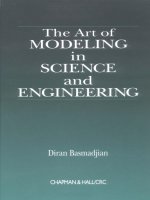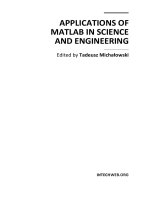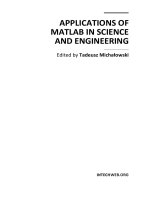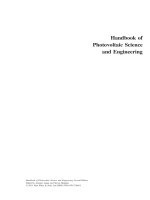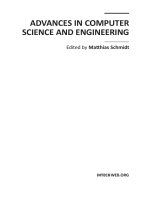MATHEMATICAL METHODS IN SCIENCE AND ENGINEERING ppt
Bạn đang xem bản rút gọn của tài liệu. Xem và tải ngay bản đầy đủ của tài liệu tại đây (26.25 MB, 709 trang )
MATHEMATICAL
METHODS
IN
SCIENCE
AND ENGINEERING
This Page Intentionally Left Blank
MATHEMATICAL
METHODS IN
SCIENCE
AND ENGINEERG
S.
SELCUK
BAYIN
Middle
East
Technical
University
Ankara,
Turkey
@K&CIENCE
A
JOHN
WILEY
&
SONS,
INC.,
PUBLICATION
Copyright
0
2006
by John Wiley
L
Sons, Inc.
All
rights reserved.
Published by John Wiley
&
Sons, Inc., Hoboken, New Jersey.
Published simultaneously in Canada.
No
part of this publication may
be
reproduced, slored in a mtrieval
system,
or
transmitted in any form
or
by
any
means, electronic, mechanical, photocopying, recording, scanning,
or
otherwise, except as
permitted under Section
107
or
108
of
the
1976
United States Copyright Act, without either the prior
written permission of the
Publisher,
or
authorization through paymcnt
of
tbe appropriate pcr-copy fee to
the Copyright Clearance Center, Inc.,
222
Rosewood Drive,
Danvers,
MA
01923, (978) 750-8400,
fax
(978) 750-4470,
or
on the web at www.copyright.com. Requests to the Publisher for permission
should
be
addressed to the Permissions
Department,
John Wiley
&
Sons, Inc.,
11 1
River
Street,
Hoboken, NJ
07030, (201) 748-601
1,
fax
(201) 748-6008,
or
online at
http://~.wiley.co~go~s~on.
Limit of LiabilityDisclaimer
of
Warranty: While the publisher and author have used theirbest efforts in
preparing this
book,
they make no rcpresentations
or
warranties with respect
to
the accuracy
or
completeness of the contents
of
this
book
and
spccificalty disclaim
any
implied warranties
of
merchantability
or
fitness for a particular purpose.
No
warranty may
be
created
or
extended by sales
representatives
or
written sales materials. The advice and strategies contained henin may not
be
suitable
for
your situation.
You
should consult with a professional wherc appropriate. Neither the
publisher nor author shall
be
liable
for
any
loss
ofprofit
or
any other commercial damages, including
but
not limited to special, incidental, consequential,
or
other damages.
For
general information on
our
other products and services
or
for technical
support,
please contact
our
Customer
Care
Depment within the United States at
(800)
762-2974,
outside the United States at
(317)572-3993
or
fax(317)572-4002.
Wiley
also
publishes its books in a variety
of
electronic formats. Some content that appem in print may
not
be
available in electronic format.
For
information about Wiley products, visit
our
web site at
www.wiley.com
Libmv
of
Congress ~ing4n-PuMication
Data
is
~~.
ISBN-I3 978-0-470-04142-0
ISBN-10 0-470-04142-0
Printed in the United States of America
10987654321
Contents
Preface xxz
Acknowledgments xxuii
1
NATURE and MATHEMATICS
1
1.1 Mathematics and Nature
3
1.2 Laws
of
Nature
4
1.3
Mathematics and Mind
5
1.4
Is Mathematics the Only Language for Nature?
6
1.5 Nature and Mankind
7
2
LEGENDRE EQUATION and POLYNOMIALS
2.1 Legendre Equation
2.2
2.3
Legendre Polynomials
2.1.1
Method
of
Separation
of
Variables
Series Solution
of
the Legendre Equation
2.2.1 Fro benius Method
2.3.1 Rodriguez Formula
2.3.2
Generating Function
2.3.3
Recursion Relations
2.3.4
Special Values
9
10
12
13
16
17
19
19
21
22
V
vi
CONTENTS
3
2.3.5 Special Integrals
2.9.6 Orthogonality and Completeness
Associated Legendre Equation
and
its Solutions
2.4.1 Associa,ted Legendre Polynomials
2.4.2
Orthogonality
of
the Associated Legendre
Polynomials
2.4
2.5 Spherical Harmonics
Problems
LAGUERRE POLYNOMIALS
3.1 Laguerre Equa,tion
and
Polynomials
3.2 Other Definitions
of
Laguerre Polynomials
3.2.1 Generating Function
of
Laguerre
3.2.2
Polynomials
Rodriguez Formula for the Laguerre
Polynomials
3.3
Orthogonality
of
Laguerre Polynomials
3.4
Other Properties
of
Laguerre Polynomials
3.4.1 Recursion Relations
3.4.2 Special Values
of
Laguerre Polynomials
Associated Laguerre Equation
and
Polynomials
Properties
of
Associated Laguerre Polynomials
3.6.1 Generating Function
3.6.2 Rodriguez Formula
and
Orthogonality
3.6.3 Recursion Relations
Problems
3.5
3.6
4
HERMITE POLYNOMIALS
4.1
Hermite Equation
and
Polynomials
4.2
Other Definitions
of
Hermite Polynomials
4.2.1 Generating Function
4.2.2
Rodriguez Formula
Problems
4.3
Recursion Relations
and
Orthogonality
5
GEGENBAUER and CHEBYSHEV POLYNOMIALS
Gegenbauer Equation
and
its Solutions
5.1 Cosmology
and
Gegenbauer Polynomials
5.2
23
24
28
30
31
33
36
43
45
46
47
48
50
50
50
51
52
52
53
53
53
57
58
60
60
61
62
66
7f
71
75
CONTENTS
vh'
5.2.1 Orthogonality
and
the Generating
Function 75
5.3 Chebyshev Equation
and
Polynomials 75
5.3.1 Chebyshev Polynomials
of
the First Kind 75
5.3.2 Relation
of
Chebyshev
and
Gegenbauer
Polynomials 76
5.3.3 Chebyshev Polynomials
of
the Second
Kind 76
5.3.4 Orthogonality
and
the Generating
Function
of
Chebyshev Polynomials 78
5.3.5 Another Definition for the Chebyshev
Polynomials
of
the Second Kind 78
Problems 79
6
BESSEL FUNCTIONS
6.1 Bessel's Equation
6.2 Solutions
of
Bessel's Equation
6.2.1
6.2.2
Bessel Functions
J*tm(x), Nm(x),
and
Modified
Bessel Functions
Im(x)
and
K,(x)
Hy
(x)
6.2.3 Spherical Bessel Functions
jl(x),
nl(x),
and
hi'72)(x)
6.3
Other Definitions
of
the Bessel Functions
6.3.1 Generating Function
6.3.2 Integral Definitions
Recursion Relations
of
the Bessel Functions
Orthogonality
and
the Roots
of
the Bessel
Functions
Boundary Conditions for the Bessel Punctions
Wronskians
of
Pairs
of
Solutions
Problems
6.4
6.5
6.6
6.7
7
HYPER GEOME TRIC FUNCTIONS
7.1
Hypergeometric Series
83
85
86
86
88
88
89
89
90
90
90
91
95
97
99
99
7.2 Hypergeometric Representations
of
Special
Functions 103
Problems 105
7.3 Con&
en
t
Hype
rg
eome
tric Equation
104
viii
CON TEN TS
8 STURM-LIOUVILLE THEORY
8.1 Self-Adjoint Digerential Operators
8.2 Sturm-Liouville Systems
8.3 Hermitian Operators
8.4 Properties
of
Hermitian Operators
8.4.1
Real Eigenvalues
8.4.2 Orthogonality
of
Eigenfunctions
8.4.3
Completeness
of
the Set of Eigenfunctions
{urn
(x>)
8.5 Generalized Fourier Series
8.6 Trigonometric Fourier Series
8.7
Hermitian Operators
in
Quantum Mechanics
Problems
107
107
I
08
110
110
111
111
112
113
114
115
118
9
STURM-LIOUVILLE SYSTEMS
and
the FACTORIZATION
METHOD 121
9.1
Another Form for the Sturm-Liouville Equation
122
9.2 Method
of
Factorization 123
9.3 Theory
of
Factorization
and
the Ladder Operators
124
9.4 Solutions via
the
Factorization Method 130
9.4.1
Case I
(
m
>
0
and
p(m)
is
an
increasing
function) 130
9.4.2
Case
11
m
>
0
and
p(m)
is a decreasing
function
I
131
9.5 Technique
and
the Categories
of
Factorization 132
9.5.1 Possible Forms for
Ic(z,m)
1
33
9.6 Associated Legendre Equation (Type
A)
137
9.6.1 Determining the Eigenvalues
XL
139
9.6.3
9.6.2 Construction
of
the Eigenfunctions
140
Harmonics
141
9.6.4
Interpretation
of
the
L*
Operators 143
Ladder Operators for the Spherical
9.6.5 Ladder Operators for the
1
Eigenvalues
145
9.7 Schrodinger Equation for
a
Single-Electron Atom
and the Factorization Method (Type F) I51
9.8 Gegenbauer Functions (Type
A)
1
53
9.10 Bessel Functions (Type
C)
155
9.11 Harmonic Oscillator (Type
D)
156
9.9 Symmetric Top (Type
A)
154
CONTENTS
ix
Problems
157
10
COORDINATES and TENSORS
10.1
Cartesian Coordinates
10.1.1
Algebra
of
Vectors
10.1.2
Diflerentiation of Vectors
10.2
Orthogonal Transformations
10.2.1
Rotations About Cartesian Axes
10.3
Formal Properties of the Rotation Matrix
10.4
Euler Angles and Arbitrary Rotations
10.5
Active and Passive Interpretations of Rotations
10.6
Infinitesimal Transformations
10.6.1
Infinitesimal Transformations Commute
10.7
Cartesian Tensors
10.7.1
Operations with Cartesian Tensors
10.7.2
Tensor Densities or Pseudotensors
10.8
Generalized Coordinates and General Tensors
10.8.1
Contravariant and Covariant Components
10.8.2
Metric Tensor and the Line Element
10.8.3
Geometric Interpretation of Covariant
and Contravariant Components
10.9
Operations with General Tensors
10.9.1
Einstein Summation Convention
10.9.2
Contraction
of
Indices
10.9.3
Multiplication
of
Tensors
10.9.4
The Quotient Theorem
10.9.5
Equality
of
Tensors
10.9.6
Tensor Densities
10.9.7
Diflerentiation
of
Tensors
10.9.8
Some Covariant Derivatives
10.9.9
Riemann Curvature Tensor
10.9.10
Geodesics
10.9.11
Invariance and Covariance
10.10
Spacetime and Four- Tensors
10.10.1
Minkowski Spacetime
10.10.2
Lorentz Transformation and the Theory
10.20.3
Time Dilation and Length Contraction
10.10.4
Addition of Velocities
of Special Relativity
163
1
63
166
166
1
70
1
70
1
72
1
74
175
177
1
78
1
78
179
180
181
183
164
186
188
188
188
189
189
189
189
190
193
195
196
197
197
197
199
801
201
x
CONTENTS
10.10.5
Four- Tensors
in
Minkowski Spacetime
10.10.6
Four- Velocity
10.10.7
Four-Momentum and Conservation Laws
10.10.8
Mass of a Moving Particle
10.10.9
Wave
Four-
Vector
10.10.10
Derivative Operators
in
Spacetime
10.10.11
Relative Orientation of Axes
in
R
and
10.10.12
Maxwell’s Equations
in
Minkowski
10.10.13
Transformation of Electromagnetic
10.10.14
Maxwell’s Equations
in
Terms of
10.10.15
Covariance of Newton’s Dynamical
Problems
K
Frames
Space time
Fields
Potentials
Theory
11
CONTINUOUS GROUPS and REPRESENTATIONS
11.1
Definition of a Group
11.1.1
Terminology
11.2
Infinitesimal
Ring
or Lie Algebra
11.3
Lie Algebra
of
the Rotation Group
R(3)
11.3.1
Another Approach to
TR(3)
11.4
Group Invariants
11.4.1
Lorentz Transformation
11.5
Unitary Group
in
Two Dimensions:
U(2)
11.6
Special Unitary Group
SU(2)
11.7
Lie Algebra
of
sU(2)
I
I.
7.1
Another Approach to
‘SU(2)
11.8
Lorentz Group and its Lie Algebra
11.9
Group Representations
1
I.
9.1
Schur
’s
Lemma
11.9.2
Group Character
11.9.3
Unitary Representation
11.10
Representations of
R(3)
1
I.
11
Spherical Harmonics and Representations of
R(3)
11.11.1
Angular Momentum
in
Quantum
Mechanics
202
204
205
207
208
208
209
21
1
213
214
21
5
21
6
223
224
224
226
227
228
231
232
234
236
237
239
24
1
24
6
24
7
24
7
248
248
249
249
CONTENTS
xi
11.11.2
Rotation of the Physical System
11.11.3
Rotation Operator
in
Terms of the Euler
11.11.4 Rotation Operator
in
Terms of the
1 1.1
1.5
Eigenvalue Equations for
L,,
Lk,
and
L2
11.11.6
Generalized Fourier Expansion
in
11.11.7
Matrix Elements ofL,,Lv, and
L,
11.11.8
Rotation Matrices for the Spherical
11.11.9
Evaluation of the
di,m(,f?)
Matrices
11.19.10
Inverse of the
dirm(p)
Matrices
11.11.11
Differential Equation for
dk,m(/3)
11.11.12
Addition Theorem for Spherical
11.11.13
Determination of
I,
in
the Addition
Angles
Original Coordinates
Spherical Harmonics
Harmonics
Harmonics
Theorem
11.12
Irreducible Representations
of
SU(2)
11.13
Relation of
SU(2)
and
R(3)
11.14
Group Spaces
11.14.1
Real Vector Space
11.14.2
Inner Product Space
11.14.3
Four- Vector Space
11.14.4
Complex Vector Space
11.14.5
Function Space and Hilbert Space
11.14.6
Completeness of the Set of Eigenfunctions
(urn
(XI}
11.15
Hilbert Space and Quantum Mechanics
11.16
Continuous Groups and Symmetries
11.16.1
One-Parameter Point Groups and Their
11.16.2
Transformation of Generators and
11.16.3
The Case
of
Multiple Parameters
11.16.4
Action of Generators on Functions
1
1.16.5
Infinitesimal Transformation of
Derivatives: Extension of Generators
11.16.6
Symmetries of Differential Equations
Generators
Normal Forms
250
251
251
255
255
257
258
260
261
262
264
266
268
269
272
272
273
274
274
274
275
276
277
278
279
281
281
282
285
Problems
288
xi;
CONTENTS
12
COMPLEX VARIABLES and FUNCTIONS
12.1
Complex Algebra
12.2
Complex Functions
12.3
Complex Derivatives and Analytic Functions
12.3.
I
Analytic Functions
12.3.2
Harmonic Functions
12.4.1
Conformal Mappings
12.4.2
Electrostatics and Conformal Mappings
12.4.3
Fluid Mechanics and Conformal Mappings
12.4.4
Schwarz- Christ0 ffel Trans formations
Problems
12.4
Mappings
13
COMPLEX INTEGRALS and SERIES
13.1
Complex Integral Theorems
13.2
Taylor Series
13.3
Laurent Series
13.4
Classification
of
Singular Points
13.5
Residue Theorem
13.6
Analytic Continuation
13.7
Complex Techniques
in
Taking Some Definite
Integrals
13.8
Gamma and Beta Functions
13.8.1
Gamma Function
13.8.2
Beta Function
13.8.3
Useful Relations
of
the Gamma Functions
13.8.4
Incomplete Gamma and Beta Functions
13.9
Cauchy Principal Value Integral
13.10
Contour Integral Representations
of
Some Special
Functions
13.10.1
Legendre Polynomials
13.10.2
Laguerre Polynomials
Problems
14
FRA CTIO NA L DERIVATIVES and INTEGRA
LS:
“DIFFER INTEGR A LS”
14.1
Unified Expression
of
Derivatives and Integrals
14.1.1
Notation and Definitions
14.1.2
The nth Derivative
of
a Function
293
293
295
296
297
299
300
313
314
318
322
329
335
335
339
340
34
7
34
7
349
352
360
360
362
364
364
365
369
369
371
373
379
381
381
382
CON
TENTS
xiii
14.2.3 Successive Integrals 384
14.1.4
Unification
of
Derivative and Integral
Operations for Integer Orders
385
14.2
Differint egrals
385
14.2.1
Griinwald’s Definition
of
Differintegrals
385
14.2.2
Riemann-Liouville Definition
of
Differintegrals
387
14.3 Other Definitions
of
Diflerintegrals 390
14.3.1 Cauchy Integral Formula 390
14.3.3
Diflerintegrals via Laplace Transforms 396
14.3.2
Ri
emann Formula
395
14.4
Properties
of
Differintegrals 399
14.4.1
Linearity 399
14.4.2
Homogeneity 399
14.4.3 Scale Transformation
400
14.4.4
Differintegral
of
a Series
400
14.4.5
Composition
of
Diflerintegrals
4
00
14.4.6 Leibniz’s Rule
407
14.4.7
Right- and Left-Handed Diflerintegrals
407
14.4.8
Dependence on the Lower Limit
4
08
14.5 Differintegrals
of
Some Functions
4
09
14.5.1
Differintegral
of
a Constant
409
14.5.2 Differintegral
of
[x
-
u]
410
14.5.3 Differintegral
of
[x
-u]p
(p
>
-1)
411
14.5.4 Differintegral
of
[I
-XI*
412
14.5.5
Diflerintegral
of
exp(
fx)
412
14.5.6 Differintegral
of
In(x)
412
14.6
Mathematical Techniques with Differintegrals
413
14.6.1
Laplace Transform
of
Differintegrals 413
14.6.2
Extraordinary Diflerential Equations
427
14.6.3 Mittag-LefJler Functions
418
14.6.4
Semidifferential Equations
419
14.5.7 Some Semiderivatives and Semi-integrals
413
14.6.5 Evaluating Definite Integrals
by
Differintegrals
14.6.6 Evaluation
of
Sums
of
Series
by
14.6.7
Special Functions Expressed as Diflerintegrals
421
Differint egrals
423
424
xiv
CONTENTS
14.7
Applications
of
Diflerintegrals in Science
and
Engineering
424
14.7.2
Fractional Fokker-Planck Equations
427
Problems
429
14.7.1 Continuous Time Random Walk (CTRW)
424
15 INFINITE SERIES 431
15.1 Convergence
of
Infinite Series
431
15.2 Absolute Convergence 432
15.3 Convergence Tests
433
15.3.1 Comparison Test 433
15.3.2 Ratio Test
433
15.3.3 Cuuchy Root Test
433
15.3.4 Integral Test
434
15.3.5 Raabe Test 435
15.3.6 Cauchy Theorem 435
15.3.7 Gauss Test and Legendre Series 436
15.3.8 Alternating Series 439
15.4 Algebra
of
Series
439
15.4.1 Rearrangement
of
Series
440
15.5 Useful Inequalities About Series
442
15.6 Series
of
Functions
442
15.6.1 Uniform Convergence 443
15.6.2 Weierstrass M-Test
443
15.6.3 Abel Test
444
15.7 Taylor Series 445
15.7.
I
Maclaurin Theorem
446
15.7.2 Binomial Theorem
44
7
Variables
44s
15.8 Power Series
449
15.8.1 Convergence
of
Power Series 450
15.8.2 Continuity
450
Series 450
15.8.4 Uniqueness Theorem 451
15.8.5 Inversion
of
Power Series
451
15.9 Summation
of
Infinite Series 452
15.6.4 Properties
of
Uniformly
Convergent Series
445
15.7.3 Taylor Series
for
Functions with Multiple
15.8.3 Differentiation
and
Integration
of
Power
CONTENTS
xv
15.9.1 Bernoulli Polynomials and Their
Properties
452
15.9.2 Euler-Maclaurin Sum Formula
454
15.9.3 Using Residue Theorem to Sum Infinite
Series
458
15.9.4 Evaluating Sums
of
Series
by
Digerintegrals
4
61
15.9.5 Asymptotic Series
4
62
15.10 Divergent Series
in
Physics
4
65
15.10.1 Casimir Eflect and Renormalization
4
65
15.10.2 Casimir Egect and MEMS
468
15.11 Infinite Products
4
68
15.11.1 Sine, Cosine, and the Gamma Functions
470
Problems
4
72
1
6
INTEGRAL TRA NSFORMS
4
77
16. 1 Some Commonly Encountered Integral Transforms
4
78
16.2
Derivation
of
the Fourier Integral
16.2.1
Fourier Series
16.2.2 Dirac-Delta Function
16.3 Fourier and Inverse Fourier Transforms
16.3.1 Fourier Sine and Cosine Transforms
16.3.2 Fourier Transform
of
a Derivative
16.3.3 Convolution Theorem
16.3.4 Existence
of
Fourier Transforms
16.3.5 Fourier Transforms
in
Three Dimensions
16.4 Some Theorems on Fourier Transforms
16.5 Laplace Transforms
16.6 Inverse Laplace Transforms
16.6.1 Bromwich Integral
16.6.2 Elementary Laplace Transforms
16.6.3 Theorems About Laplace Transforms
16.6.4 Method
of
Partial Fractions
16.7 Laplace Transform
of
a Derivative
16.7.1 Laplace Transforms
in
n
Dimensions
16.8 Relation Between Laplace and Fourier Transforms
51 1
16.9 Mellin Transforms
4
79
4
79
481
481
482
484
485
486
486
487
490
491
492
492
494
501
503
51 1
51
2
xvi
CONTENTS
Problems
17
VARIATIONAL ANALYSIS
17.1 Presence
of
One Dependent and One Independent
Variable
17.1.1 Euler Equation
17.1.2 Another Form
of
the Euler Equation
17.1.3
Applications
of
the Euler Equation
17.2 Presence
of
More Than One Dependent Variable
17.3
Presence
of
More Than One Independent
Variable
17.4
Presence
of
More
Than One Dependent
and
Independent Variables
17.5 Presence
of
Higher-Order Derivatives
17.6 Isoperimetric Problems
and
the Presence
of
Constraints
17.7
Application
to
Classical Mechanics
17,8 Eigenvalue Problem and Variational Analysis
17.9 Rayleigh-Ritz Method
Problems
18 INTEGRAL EQUATIONS
18.1 Classification
of
Integral Equations
18.2 Integral
and
Differential Equations
18.3
How
to
Convert Some Differential Equations
into
Integral Equations
18.4
How
to Convert Some Integral Equations into
Differen tial Equations
18.5 Solution
of
Integral Equations
18.5.1 Method of Successive Iterations:
Neumann Series
18.5.2 Error Calculation
in
Neumann Series
512
51
7
518
518
520
520
523
524
526
527
529
533
535
539
543
54 7
548
548
550
552
553
554
556
18.5.3 Solution for the Case
of
Separable Kernels 556
18.5.4 Solution
of
Integral Equations
by
Integral
18.6 Integral Equations
and
Eigenvalue Problems
(Hilbert-Schmidt Theory) 560
18.6.1 Eigenvalues Are Real for Hermitian
Ope rat
o
rs 560
18.6.2 Orthogonality
of
Eigenfunctions 562
Transforms 559
CONTENTS
18.6.3 Completeness
of
the Eigenfunction Set
Kernels
Problems
18.7 Eigenvalue Problem for the Non-Hermitian
19 GREEN’S FUNCTIONS
19.1 Time-Independent Green’s Functions
19.1.1
Green’s Functions
in
One Dimension
19.1.2 Abel’s Formula
19.1.3 How to Construct
a
Green’s Function
19.1.4 The Differential Equation That the
Green’s Function Satisfies
19.1.5 Single-Point Boundary Conditions
19.1.6 Green’s Function for the Operator
d2/dx2
19.1.7 Green’s Functions for Inhomogeneous
Boundary Conditions
19.1.8 Green’s Functions
and
the Eigenualue
Problems
19.1.9 Green’s Function for the Helmholtz
Equation
in
One Dimension
19.1.10 Green’s Functions
and
the Dirac-Delta
Function
19.1.11 Green’s Function for the Helmholtz
Equation for All Space- Continuum Limit
19.1.12 Green’s Function for the Helmholtz
Equation
in
Three Dimensions
19.1.13 Green’s Functions
in
Three Dimensions
with
a
Discrete Spectrum
19.1.14 Green’s Function for the Laplace Operator
Inside
a
Sphere
19.1.15 Green’s Functions for the Helmholtz
Equation for
All
Space-Poisson
and
Schrodinger Equations
19.1.16 General Boundary Conditions
and
Applications
to
Electrostatics
19.2.1 Green’s Functions with First-Order Time
Dependence
19.2.2 Propagators
19.2 Time-Dependent Green’s Functions
xvii
562
564
565
567
567
567
569
569
572
572
573
575
579
582
583
584
593
594
596
597
603
606
606
609
19.2.3 Compounding Propagators 609
xviii
CONTENTS
19.2.4 Propagator for the Digusion Equation
19.2.5 Propagator for the Digusion Equation
in
19.2.6 Green’s Functions
in
the Presence
of
19.2.7 Green’s Function for the Schrodinger
19.2.8 Green’s Function for the Schrodinger
19.2.9 Second-Order Time-Dependent Green’s
19.2.10 Propagators for the Scalar Wave
19.2.11 Advanced
and
Retarded Green’s Functions
19.2.12 Advanced
and
Retarded Green’s Functions
Problems
with Periodic Boundary Conditions
the Continuum Limit
Sources or Interactions
Equation for Free Particles
Equation
in
the Presence
of
Interactions
Functions
Equation
for
the Scalar Wave Equation
20
GREEN’S FUNCTIONS and PATH INTEGRALS
20.1 Brownian
Motion
and
the Digusion Problem
20.2
Wiener Path Integral Approach
to
Brownian
Motion
20.3 The Feynman-Kac Formula and the Perturbative
Solution
of
the Bloch Equation
20.4 Derivation
of
the Feynman-Kac Formula
20.5 Interpretation
of
V(x)
in
the Bloch Equation
20.6 Methods
of
Calculating Path Integrals
20.6.1 Method
of
Time Slices
20.6.2 Evaluating Path Integrals with the ESKC
20.6.3 Path Integrals
by
the Method
of
Finite
20.6.4 Path Integrals
by
the “Semiclassical”
20.7
Feynman Path Integral Formulation
of
Quantum
Relation
Elements
Method
Mechanics
20.7.1
Schrodinger Equation
for
a
Free Particle
20.7.2
Schrodinger Equation
in
the Presence
of
Interactions
20.8 Feynman Phase Space Path Integral
61 0
61
1
61
3
61
5
61
5
61 6
61 8
621
624
626
633
633
635
64
9
650
650
655
655
658
659
CONTENTS
xix
20.9 Feynman Phase Space Path Integral
in
the Presence
of
Quadratic Dependence
on
Momentum 660
Problems 663
References
Index
665
669
This Page Intentionally Left Blank
Preface
Courses on mathematical methods of physics
are
among the essential courses
for
graduate programs in physics, which
are
also offered by most engineering
departments. Considering that the audience in these coumes comes from all
subdisciplines
of
physics and engineering, the content and the level of math-
ematical formalism has to be chosen very carefully. Recently the growing in-
terest in interdisciplinary studies has brought scientists together from physics,
chemistry, biology, economy, and finance and has increased the demand for
these courses in which upper-level mathematical techniques are taught.
It
is
for this reason that the mathematics departments, who once overlooked these
courses, are now themselves designing and offering them.
Most
of
the available books
for
these courses
are
written with theoretical
physicists in mind and thus are somewhat insensitive to the needs
of
this new
multidisciplinary audience. Besides, these books should not only
be
tuned
to the existing practical needs of this multidisciplinary audience but should
also play
a
lead role in the development
of
new interdisciplinary science by
introducing new techniques to students and researchers.
About
the
Book
We give
a
coherent treatment
of
the selected topics with
a
style that makes
advanced mathematical tools accessible to
a
multidisciplinary audience. The
book is written in
a
modular way
so
that each chapter
is
actually
a
review of
mi
mii
PREFACE
its subject and can be read independentIy. This makes the book very useful
as
a reference for scientists. We emphasize physical motivation and the mul-
tidisciplinary nature of the methods discussed.
The entire book contains enough material for a three-semester course meet-
ing three hours a week. However, the modular structure of the book gives
enough flexibility to adopt the book for several different advanced undergrad-
uate and graduatelevel courses. Chapter 1 is a philosophical prelude about
physics, mathematics, and mind for the interested reader. It is not a part
of
the curriculum for courses on mathematical methods of physics. Chapters
2-8, 12, 13 and
15-19
have been used for a tw+semester compulsory gradu-
ate course meeting three hours a week. Chapters 16-20 can be used for an
introductory graduate course on Green’s functions.
For
an upper-level un-
dergraduate course on special functions, colleagues have used Chapters 1-8.
Chapter 14 on fractional calculus can be expanded into a one-term elective
course supported by projects given to students. Chapters 2-11 can be used
in an introductory graduate course, with emphasis given to Chapters 8-11
on Stunn-Liouville theory, factorization method, coordinate transformations,
general tensors, continuous groups, Lie algebras, and representations.
Students are expected to be familiar with the topics generally covered dur-
ing the first three years of the science and engineering undergraduate curricu-
lum. These basically comprise the contents of the books
Advanced Calculus
by
Kaplan,
Introductory Complex Analysis
by Brown and Churchill, and
Difler-
ential Equations
by
Ross,
or
the contents of books like
Mathematicab Methods
in
Physical Sciences
by Boas,
Mathematical Methods: for Students
of
Physics
and Related Fields
by Hassani, and
Essential Mathematical Methods
for
Physi-
cists
by Arfken and Weber. Chapters
(10
and 11) on coordinates, tensors, and
groups assume that the student has already seen orthogonal transformations
and various coordinate systems. These are usually covered during the third
year of the undergraduate physics curriculum at the level of
Classical Me-
chanics
by Marion
or
Theoreticab Mechanics
by Bradbury.
For
the sections
on special relativity (in Chapter
10)
we assume that the student is familiar
with basic special relativity, which is usually covered during the third year
of undergraduate curriculum in modern physics courses with text books like
Concepts
of
Modern Physics
by Beiser.
Three very interesting chapters on the method of factorization, fractional
calculus, and path integrals are included for the first time in a text book
on
mathematical methods. These three chapters are also extensive reviews of
these subjects for beginning researchers and advanced graduate students.
Summary
of
the
Book
In Chapter
1
we
start with a philosophical prelude about physics, mathemat-
ics, and mind.
In Chapters 2-6 we present a detailed discussion of the most frequently
PREFACE
xviii
encountered special functions in science and engineering. This is also very
timely, because during the first year
of
graduate programs these functions
are used extensively. We emphasize the fact that certain second-order par-
tial differential equations are encountered in many different areas of science,
thus allowing one to use similar techniques. First we approach these partial
differential equations by the method
of
separation of variables and reduce
them to
a
set
of
ordinary differential equations. They are then solved by the
method
of
series, and the special functions are constructed by imposing appro-
priate boundary conditions. Each chapter is devoted to
a
particular special
function, where it
is
discussed in detail. Chapter
7
introduces hypergeometric
equation and its solutions. They are very useful in parametric representations
of the commonly encountered second-order differential equations and their
so-
lutions. Finally our discussion of special functions climaxes with Chapter
8,
where
a
systematic treatment of their common properties is given in terms
of
the Sturm-Liouville theory. The subject
is
now approached
as
an eigenvalue
problem for second-order linear differential operators.
Chapter
9
is
one of the special chapters of the book. It
is
a
natural extension
of the chapter on Sturm-Liouville theory and approaches second-order differ-
ential equations of physics and engineering from the viewpoint
of
the theory
of factorization. After a detailed analysis of the basic theory we discuss spe-
cific cases. Spherical harmonics, Laguerre polynomials, Hermite polynomials,
Gegenbauer polynomials, and Bessel functions are revisited and studied in
detail with the factorization method. This method
is
not only an interesting
approach to solving Sturm-Liouville systems, but also has deep connections
with the symmetries of the system.
Chapter
10
presents an extensive treatment of coordinates, their transfor-
mations, and tensors. We start with the Cartesian coordinates, their trans-
formations, and Cartesian tensors. The discussion is then extended to general
coordinate transformations and general tensors. We also discuss Minkowski
spacetime, coordinate transformations in spacetime, and four-tensors in
de-
tail. We also write Maxwell’s equations and Newton’s dynamical theory in
covariant form and discuss their transformation properties in spacetime.
In Chapter
11
we discuss continuous groups, Lie algebras, and group rep-
resentations. Applications to the rotation group, special unitary group, and
homogeneous Lorentz group are discussed in detail. An advanced treatment
of spherical harmonics is given in terms of the rotation group and its repre
sentations. We also discuss symmetry of differential equations and extension
(prolongation)
of
generators.
Chapters
12
and
13
deal with complex analysis. We discuss the theory of
analytic functions, mappings, and conformal and Schwarz-Christoffel trans-
formations with interesting examples like the fringe effects of
a
parallel plate
capacitor and fluid flow around an obstacle. We also discuss complex inte-
grals, series, and analytic continuation along with the methods of evaluating
some definite integrals.
Chapter
14
introduces the basics of fractional calculus. After introducing
xxiv
PREFACE
the experimental motivation
for
why we need fractional derivatives and inte-
grals, we give
a
unified representation of the derivative and integral and extend
it
to fractional orders. Equivalency of different definitions, examples, prop
erties, and techniques with fractional derivatives are discussed. We conclude
with examples from Brownian motion and the Fokker-Planck equation. This
is
an emerging field with enormous potential and with applications
to
physics,
chemistry, biology, engineering, and finance.
For
beginning researchers and
instructors who want to
add
something new and interesting to their course,
this self-contained chapter is an excellent place to start.
Chapter
15
contains
a
comprehensive discussion of infinite series: tests of
convergence, properties, power
series,
and uniform convergence along with
the methods
of
evaluating
sums
of
infinite series. An interesting section on
divergent
series
in physics is added with
a
discussion
of
the Casimir effect.
Chapter
16
treats integral transforms. We start with the general defini-
tion, and then the two most commonly used integral transforms, Fourier and
Laplace transforms, are discussed in detail with their various applications and
techniques.
Chapter
17
is on variational analysis. Cases with different numbers of
de-
pendent and independent variables are discussed. Problems with constraints,
variational techniques in eigenvalue problems, and the Rayleigh-Ritz method
are among other interesting topics covered.
In Chapter
18
we introduce integral equations. We start with their classifi-
cation and their relation
to
differential equations and vice versa. We continue
with the methods
of
solving integral equations and conclude with the eigen-
value problem for integral operators, that is, the Hilbert-Schmidt theory.
In Chapter
19
(and
20)
we present Green’s functions, and this is the second
climax of this book, where everything discussed
so
far
is
used and their con-
nections seen. We start with the timeindependent Green’s functions in one
dimension and continue with three-dimensional Green’s functions. We discuss
their applications to electromagnetic theory and the Schrijdinger equation.
Next we discuss first-order time-dependent Green’s functions with applica-
tions to diffusion problems and the timedependent Schrodinger equation. We
introduce the propagator interpretation and the compounding
of
propagators.
We conclude this section with second-order time-dependent Green’s functions,
and their application to the wave equation and discuss advanced and retarded
soh
tions.
Chapter
20
is
an extensive discussion of path integrals and their relation
to Green’s functions. During the past decade
or
so
path integrals have found
wide range
of
applications among many different fields ranging from physics
to
finance. We start with the Brownian motion, which is considered
a
pro-
totype
of
many different processes in physics, chemistry, biology, finance etc.
We discuss the Wiener path integral approach to Brownian motion. After the
Feynman-Kac formula
is
introduced, the perturbative solution
of
the Bloch
equation is given. Next an interpretation of
V(z)
in the Bloch equation is
given, and we continue with the methods of evaluating path integrals. We


